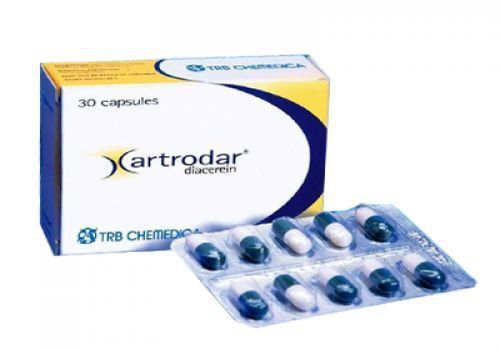This is an automatically translated article.
Stadloric 200 with the main ingredient is Celecoxib 200mg, indicated in the symptomatic treatment of osteoarthritis, rheumatoid arthritis in adults, adjuvant therapy to reduce the number of colorectal adenomatous polyps. family, acute pain treatment, .... Let's learn the use of Stadloric 200 through the article below.
1. Uses of Stadloric 200
1.1 Indications Stadloric 200 6X10 Stada is indicated for use in the following cases:
Symptomatic treatment of osteoarthritis, rheumatoid arthritis in adults. Adjuvant therapy to reduce the number of familial adenomatous polyps. Treatment of acute pain, including pain after surgery, tooth extraction. Treatment of primary dysmenorrhea. 1.2 How to use - Dosage How to use:
Take orally with or without food. When using celecoxib to treat osteoarthritis in adults, the dose must be adjusted according to the needs and response of each patient, using the lowest effective dose.
Dosage
Adults:
Osteoarthritis:
Usual dose: 200mg/day orally or divided into 2 equal doses. Doses above 200 mg/day (eg, 200 mg twice daily) have not been shown to be more effective. Rheumatoid arthritis in adults:
Usual dose: 100-200 mg/time x 2 times/day. Higher doses (400 mg/time x 2 times/day) are not more effective than doses of 100-200 mg/time x 2 times/day. Colorectal polyps:
Dose 400mg/time x 2 times/day, taken with meals. The safety and efficacy of therapy over 6 months in patients with familial adenomatous polyposis have not been studied. General pain and dysmenorrhea:
400 mg orally 1 time, if necessary followed by 200 mg on the first day. For continued pain relief, a dose of 200mg orally twice a day can be given. Elderly (over 65 years old):
For elderly people with body weight less than 50kg, the lowest recommended dose must be used at the beginning of treatment.
Renal failure:
If it is necessary to use celecoxib in patients with severe renal impairment, renal function must be closely monitored. There are no special recommendations for dose adjustment in patients with chronic renal failure. Hepatic impairment:
Reduce dose by approximately 50% in patients with moderate hepatic impairment.
Note: The above dosage is for reference only. The specific dose depends on the condition and the progression of the disease. To get the right dose, you need to consult your doctor or healthcare professional.
1.3 Missed dose, overdose and management Overdose:
Overdosage of nonsteroidal anti-inflammatory drugs can cause lethargy, somnolence, nausea, and epigastric pain. These manifestations are usually reversible with supportive treatment. Gastrointestinal bleeding also occurs. Rarer manifestations are hypertension, acute renal failure, respiratory depression, and coma. Anaphylactoid reactions have been reported with therapeutic doses of non-steroidal anti-inflammatory drugs and may occur in overdose. Treatment of overdose includes symptomatic and supportive treatment; There is no specific antidote to nonsteroidal anti-inflammatory drugs. During the first 4 hours after overdose, emetic therapy and/or activated charcoal (60-100g for adults, or 1-2g/kg body weight for children), and/or an osmotic bleach may be useful for patients who already have a medical condition or have taken a large dose of the drug. Missed dose:
Add dose as soon as you remember. However, if the interval between the next dose is too short, skip the missed dose and resume the dosing schedule. Do not take a double dose to make up for a missed dose.
2. Side effects of Stadloric 200
When using Stadloric 200 6X10 Stada, you may experience unwanted effects (ADRs). Common, ADR >1/100
Gastrointestinal: Abdominal pain, diarrhea, dyspepsia, flatulence, nausea. Respiratory: Pharyngitis, rhinitis, sinusitis, upper respiratory tract infection. Central nervous system: Insomnia, dizziness, headache. Sold. General: Back pain, peripheral edema. Rarely, ADR < 1/1000
Cardiovascular: Syncope, congestive heart failure, ventricular fibrillation, pulmonary embolism, cerebrovascular accident, thrombophlebitis, vasculitis. Gastrointestinal: Intestinal obstruction, intestinal perforation, gastrointestinal bleeding, hemorrhagic colitis, esophageal perforation, pancreatitis. Hepatobiliary: Gallstone disease, hepatitis, jaundice, liver failure. Hematology: Thrombocytopenia, agranulocytosis, aplastic anemia, pancytopenia, leukopenia. Metabolism: Decreased blood glucose. Central nervous system: Ataxia, paranoia, suicide. Renal: Acute renal failure, interstitial nephritis. General: Infection, sudden death, anaphylactoid reactions, angioedema. Instructions on how to handle ADR: When experiencing side effects of the drug, it is necessary to stop using it and notify the doctor or go to the nearest medical facility for timely treatment.
3. Note when using Stadloric 200
Before using the drug you need to carefully read the instructions for use and refer to the information below.
Contraindications
Stadloric 200 6X10 Stada is contraindicated in the following cases:
Hypersensitivity to celecoxib, sulfonamides. Severe heart failure. Severe renal impairment (creatinine clearance less than 30ml/min). Severe liver failure. Inflammatory bowel disease. Progressive peptic ulcer or gastrointestinal bleeding. History of asthma, urticaria, or other allergic-type reactions to aspirin, or other NSAIDs. Celecoxib is not indicated for use in children. Celecoxib is not indicated for the treatment of pain after coronary artery bypass graft surgery. Precautions/Certificate of Use
Cardiovascular Risk: NSAIDs can increase the risk of cardiovascular thrombosis, myocardial infarction, and stroke, which can lead to death. This risk may increase with treatment. Patients with cardiovascular disease or risk factors for cardiovascular disease are at greater risk.
Gastrointestinal risks: NSAIDs can have serious gastrointestinal consequences including bleeding, ulceration, and perforation of the stomach or intestines, which can lead to death. These serious side effects can occur at any time, with or without warning symptoms, in patients treated with NSAIDs. Elderly patients are those at high risk for gastrointestinal problems.
Effects on the kidney: Long-term use of NSAIDs causes renal papillary necrosis and other kidney damage. Renal function usually recovers after discontinuation of NSAID therapy.
Renal disease: There is no information from controlled clinical studies regarding the use of celecoxib in patients with renal disease. Therefore, treatment with celecoxib is not recommended in patients with renal disease. If medication is required, the patient's renal function should be closely monitored.
Because it is not known if celecoxib reduces the risk of colorectal cancer associated with familial adenomatous polyposis, care for this condition should be continued as usual, with internal follow-up. colonoscopy, resection of the colon if necessary.
Ability to drive and use machines
Patients who experience dizziness, lightheadedness, or drowsiness while taking celecoxib should not drive or operate machinery.
Pregnancy
To date, there are no adequate studies with celecoxib in pregnant women. Celecoxib should be used during pregnancy only when the potential benefit outweighs the possible risk to the fetus. Do not use celecoxib in the third trimester of pregnancy, because prostaglandin synthesis inhibitors may have adverse effects on the cardiovascular system of the fetus.
Lactation
It is not known whether Celecoxib is distributed into breast milk. Because celecoxib can cause serious adverse effects in breastfed infants, the benefit/disadvantage needs to be weighed or whether breastfeeding should be discontinued, or celecoxib discontinued.
4. Drug interactions
Metabolism of celecoxib is mediated by cytochrome P450 2C9. Concomitant use of celecoxib with drugs that inhibit this enzyme may affect the pharmacokinetics of celecoxib, so caution should be exercised when these drugs are co-administered.
In addition, celecoxib also inhibits cytochrome P450 2D6. There is therefore the potential for an interaction between celecoxib and drugs metabolised by P450 2D6. Angiotensin-converting enzyme inhibitors: NSAIDs may reduce the antihypertensive effect of angiotensin-converting enzyme inhibitors.
Diuretics: NSAIDs may reduce the diuretic effect of furosemide and thiazides in some patients.
Aspirin: Although celecoxib can be used with low-dose aspirin, the concomitant use of these 2 NSAIDs may lead to an increased incidence of gastrointestinal ulceration or other complications, compared with celecoxib alone. Because of its lack of antiplatelet effect, celecoxib is not a substitute for aspirin for the prevention of cardiovascular disease.
Fluconazole: Co-administration of celecoxib with fluconazole may lead to a significant increase in celecoxib plasma concentrations. Treatment with celecoxib should be initiated at the lowest recommended dose in patients receiving concomitant fluconazole.
Lithium: Celecoxib may decrease the renal clearance of lithium, which leads to increased plasma concentrations of lithium. Patients receiving concomitant lithium and celecoxib should be closely monitored for signs of lithium toxicity and the dose should be adjusted accordingly when starting or stopping celecoxib.
Warfarin: Bleeding complications associated with increased prothrombin time have occurred in some patients (mainly the elderly) when celecoxib was co-administered with warfarin. It is therefore important to monitor coagulation tests such as prothrombin time, especially during the first few days after starting or changing therapy, because these patients are at high risk for bleeding complications.
Please dial HOTLINE for more information or register for an appointment HERE. Download MyVinmec app to make appointments faster and to manage your bookings easily.













